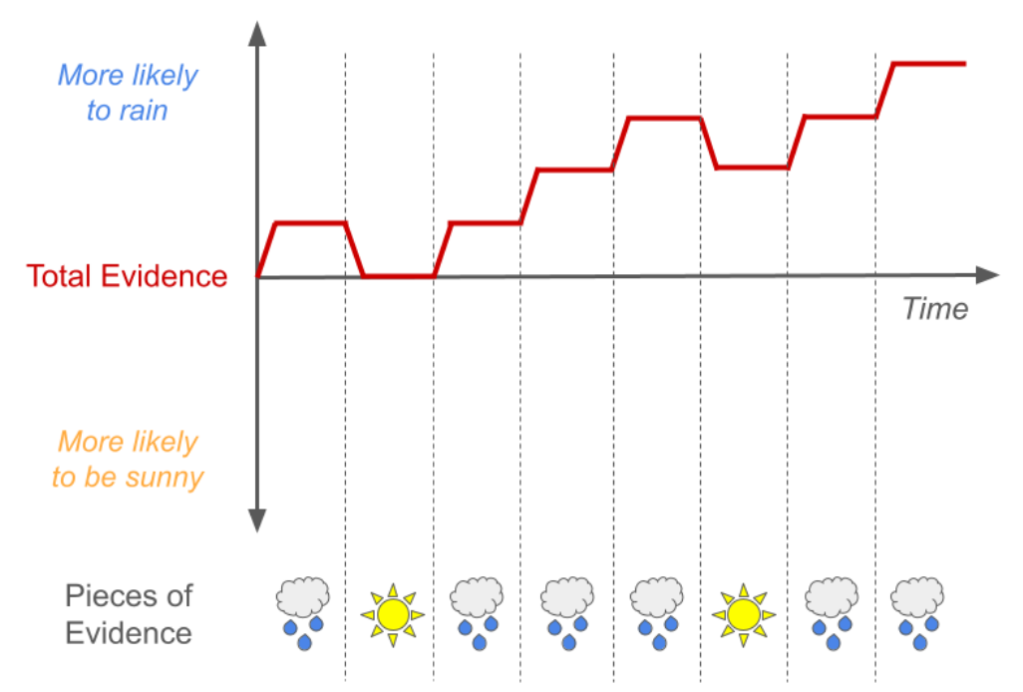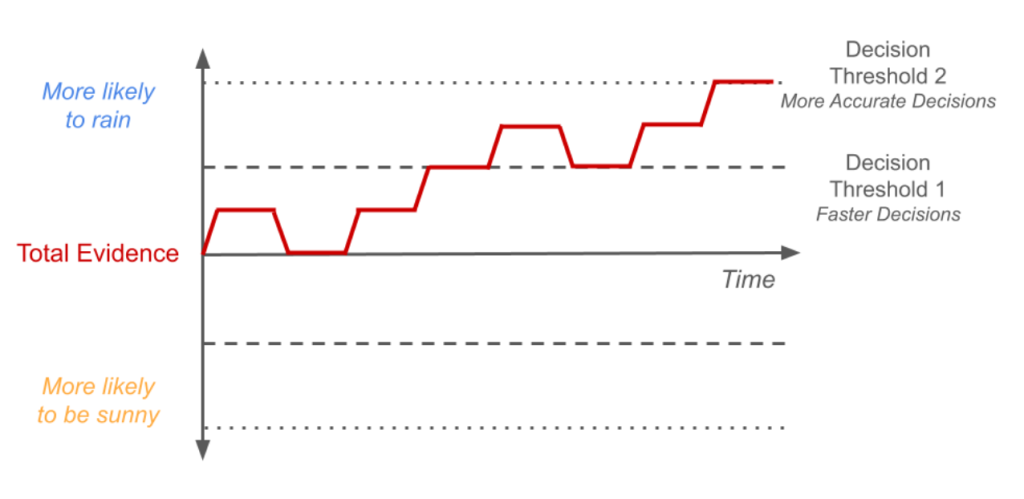June 25th, 2024
Written by: Jacob Parker
When we make decisions, we often find ourselves dealing with some level of uncertainty. For example, we rarely know exactly what the weather will be like when deciding what to wear for the day. Anyone who has ever been caught in the rain without an umbrella, in the cold without a jacket can tell you how much of a day-ruiner it can be to get this decision wrong. We can work to reduce this uncertainty (and thus decrease our odds of dressing incorrectly) by spending time looking up the forecast, looking out the window, taking a step outside, and even looking at predictions from multiple different weather centers. If we spend too much time doing this, however, we might end up missing our bus, arriving late to work, and potentially being fired. Even if this is not the case, spending too long just trying to predict the weather means we have less time to dedicate to other valuable activities such as taking care of our health, planning for the future, and making the countless other decisions we must make every day.
This example illustrates what is known in neuroscience as the speed-accuracy tradeoff, a difficult problem all decision-makers must confront1,2. The speed-accuracy tradeoff is the idea that one can make a decision quickly or they can make it accurately, but often not both simultaneously. If you only spend ten seconds figuring out the likely weather before choosing clothes, you will not be able to predict the weather as accurately as if you spent ten minutes doing so. 3,4.
While the speed-accuracy tradeoff means it is not possible to be both perfectly accurate and perfectly quick, it is certainly possible to find a balanced decision-making strategy that performs reasonably in both. Furthermore, it is also possible to adjust this strategy to prioritize either accuracy or speed more depending on which is more important for a given decision. Indeed, neuroscientists have found that the brain appears to make decisions in a way that allows it to both balance speed and accuracy, and flexibly adjust this balance depending on the circumstances3.
How the brain makes decisions
Before we talk about how the brain makes decisions, we need to first identify the basic ingredients that make up a decision3 (Figure 1). Taking the weather scenario as an example, let’s imagine now that there are only two outcomes to consider – either it will be warm and sunny or it will be cold and rainy. Each observation we can make (the forecast, what it looks like outside, what it feels like, other forecasts, etc) is a separate piece of evidence that tells us if it will be more likely to be sunny or rainy. For example, if we look outside and it is cloudy, that would be evidence that it could be cold and rainy today. If we choose to look at multiple pieces of evidence, they can be combined to form the total evidence that it will either be sunny or rainy. As we touched on when discussing the speed-accuracy tradeoff, incorporating more individual pieces of evidence makes the total evidence increasingly reliable. Finally, if the total evidence tells us it is more likely to rain, then we can choose to wear a jacket and bring an umbrella (or not if the opposite is true). In summary, we as decision-makers can observe pieces of evidence for or against certain outcomes, combine these individual pieces together into the total evidence, then choose whatever action the total evidence suggests we should3.

Now that we know the ingredients, we can take a look at how the brain turns them into a decision in a way that solves the speed-accuracy tradeoff. Neuroscientists have found that for a variety of decisions, the brain appears to track how strongly each individual piece of evidence indicates a certain outcome is likely (or not). In experiments where neuroscientists have recorded the activity of neurons (brain cells) in monkeys, individual pieces of evidence were presented to the monkey one-by-one until it chose which of two outcomes it believed was most likely. In many of these experiments, it was found that when a piece of evidence favors a specific outcome, some neurons will become more active than normal3,5. The more strongly this evidence favors that specific outcome, the more these neurons will increase their activity. Furthermore, there is a specific set of evidence-tracking neurons for each possible outcome. Crucially, neurons of this type only indicate the strength of individual pieces of evidence and are not affected by others that appeared previously. Once a piece of evidence is removed and replaced by the next one to be presented, the neurons change their activity to indicate just the strength of the current piece of evidence the monkey is looking at.
In addition to tracking individual pieces of evidence, it appears the brain also combines them into a measure of how strongly the total evidence indicates a certain outcome is likely (or not). The way the brain computes the total evidence from all of the individual pieces is actually quite straightforward. If we suppose piece of evidence 1 provides X amount of evidence that it will be rainy while piece of evidence 2 provides Y amount of evidence, the brain simply adds X and Y to get the total evidence. In other words, to get the total evidence, the brain sums together all of the individual pieces. Using experiments like the ones discussed above, neuroscientists have found neurons whose level of activity corresponds directly to the sum of the evidence (AKA the total evidence)3,6–8. For example, if the sum of the evidence strongly favors a rainy outcome, some of these neurons will be highly active, and relatively inactive if there isn’t much evidence for rain.

Returning to the speed-accuracy tradeoff
Using this measure of the total evidence computed by summing together all of the individual pieces, the brain finally chooses what action to take. This is the point of the process where the brain must finally confront the speed-accuracy tradeoff. We know that the brain could become extremely confident in its decisions by observing many pieces of evidence until the total evidence very strongly favors one of the outcomes. However, we also know that this will result in decisions made so slowly that it becomes detrimental. The brain appears to solve this conundrum in a rather simple way – it sets a decision threshold on the total evidence3. This means that once the sum of the individual pieces of evidence (again the total evidence) passes a certain threshold the brain sets, it stops observing new pieces of evidence and commits to a choice. The threshold for choosing to wear rain gear might, for example, be set such that there are 3 more pieces of evidence that it will rain than it will be sunny. Setting the threshold at a value like this allows the brain to become reasonably certain it will make the right decision while not wasting a lot of time trying to become certain to an absurd degree (e.g. waiting until there are 15 more pieces of evidence that it will rain than it will be sunny).
By adjusting this decision threshold, the brain can flexibly prioritize speed or accuracy depending on the situation4. For example, if a quick decision is needed, the brain will lower the threshold, meaning fewer pieces of evidence will be needed to push the total evidence over it. If accuracy becomes critical, the brain will raise the threshold, meaning the brain will only make a choice once it has very strong evidence it will be right.

In the brain, neuroscientists have observed something like this threshold in the very same neurons that track the strength of the total evidence. In the same kinds of experiments that we have been discussing, neuroscientists have observed that monkeys tend to make their choice once these neurons achieve a certain high level of activity3,6,8. In other words, it appears that the decision threshold is implemented in the brain as an actual activity threshold in these neurons. This activity threshold appears to be consistent even when it requires more or less time/pieces of evidence to reach it.
From this article, it might seem like neuroscientists have fully figured out how the brain makes decisions. However, there are a lot of open questions that remain. For one important one, we don’t know exactly how the “total evidence neurons” sum together all of the individual pieces of evidence. Neuroscientists currently believe that at the very least, they are connected to the “individual piece of evidence neurons” we first discussed so they can directly receive new pieces of evidence and add them to the sum of evidence they track.
Another open question is how the neuron activity threshold actually changes when a decision-maker decides to change their decision threshold. Presumably, the “total evidence neurons” will change their activity threshold accordingly, but no direct evidence for this currently exists. Despite these current unknowns, neuroscientists are steadily working toward the day that they finally cross the threshold of full understanding.
References
Cover photo by Nile from Pixabay
Figures 1-3 made by Jacob Parker in Google Slides
